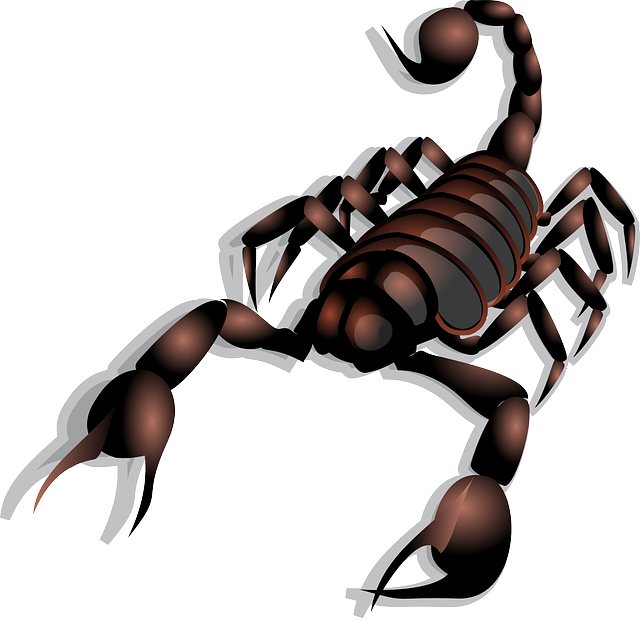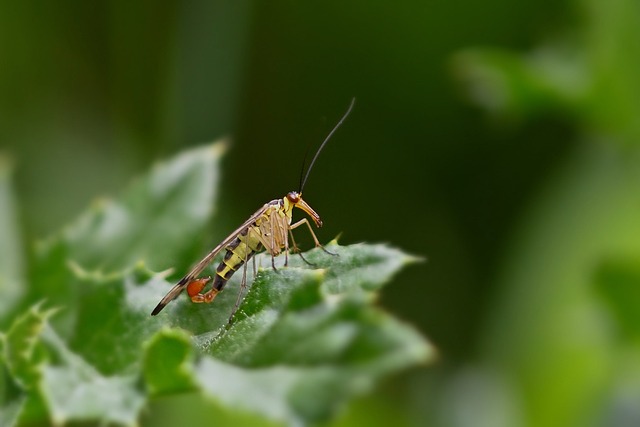Scorpions in Tucson's Sonoran Desert have adapted impressively to the harsh arid environment, with species like the Arizona bark scorpion (Pseudoscorpiones aztecus) and the stripe-tail scorpion (Vema mucronata) being particularly notable due to their potent venom and prevalence. Effective scorpion control Tucson measures are crucial to manage the risks they pose, especially to children and pets. Homeowners can mitigate scorpion infestations by sealing entry points, eliminating hiding spots, and maintaining clean, dry conditions. Professional pest control services offering tailored scorpion control Tucson solutions, including perimeter treatments, play a key role in safeguarding human health while minimizing ecological disruption. Residents are advised to adopt these practices for coexisting with scorpions, ensuring safety and ecological balance in the region. Scorpion control in Tucson involves understanding their habits and preferences, and implementing comprehensive strategies that combine prevention, targeted extermination methods, and long-term habitat management, all aimed at reducing the risk of scorpion encounters while respecting the local desert ecosystem. Regular monitoring and treatments by scorpion control experts are recommended for maintaining a secure living environment in Tucson.
In the arid expanses of Tucson’s deserts, a fascinating and often misunderstood creature thrives. This article delves into the life and habits of scorpions within this unique ecosystem, highlighting their remarkable adaptations that ensure survival amidst the harsh conditions. Explore the measures necessary for effective scorpion control in Tucson homes and yards, and learn to identify the prevalent species lurking in the region’s diverse landscape. Understanding these creatures is crucial for safely coexisting with them, employing strategies that prioritize both human safety and scorpion conservation. Through prevention, extermination, and long-term management, Tucson residents can maintain a harmonious balance with these intriguing arthropods. Join us as we unravel the secrets of scorpion behavior, adaptations, and control in Tucson’s desert environments.
- Understanding Scorpion Behavior and Adaptations in Tucson's Desert Ecosystem
- The Role of Scorpion Control Measures in Tucson Homes and Yards
- Identifying Common Scorpion Species Found in Tucson Deserts
- Scorpion Habitats: Hiding Spots and Microclimates in Tucson's Landscape
- Strategies for Coexisting with Scorpions Safely in Tucson Environments
- Effective Scorpion Control Methods: Prevention, Extermination, and Long-Term Management in Tucson
Understanding Scorpion Behavior and Adaptations in Tucson's Desert Ecosystem

Scorpions, a common fixture in Tucson’s desert environments, exhibit behaviors and possess adaptations that are both fascinating and crucial for their survival. These arachnids are highly attuned to the nocturnal patterns of the Sonoran Desert, with peak activity occurring during the cooler hours of night. Their behavior is guided by a keen sense of touch, which helps them detect vibrations in their environment—a critical defense mechanism against predators and an effective way to locate prey. Scorpions also exhibit a remarkable ability to withstand prolonged periods without water, conserving moisture through specialized structures called aerides that help prevent water loss.
The adaptations of scorpions are particularly well-suited to the harsh conditions of Tucson’s desert landscapes. Their exoskeletons provide protection and structure, while their venom is a potent tool for subduing prey and defending against threats. The venom composition can vary between species, which is an area of ongoing research in scorpion control Tucson. Some scorpions have adapted to the environment’s temperature fluctuations by changing the coloration of their bodies, darkening or lightening depending on the heat levels to regulate their internal temperature. These behaviors and adaptations contribute to the resilience and survival of scorpions in this arid ecosystem, making understanding them essential for effective scorpion control measures in Tucson. Residents can implement scorpion control strategies by maintaining clean, well-sealed environments that are less hospitable to these creatures, thus reducing the risk of encounters and potential stings.
The Role of Scorpion Control Measures in Tucson Homes and Yards

Scorpions in Tucson’s desert environments have adapted remarkably to the arid conditions, making their presence a common occurrence in both residential and natural settings. To mitigate the potential risks associated with scorpion stings, local residents often seek effective scorpion control measures. Implementing these measures is crucial for maintaining a safe living space, as Tucson’s warm climate provides an ideal habitat for these arachnids. Scorpion control Tucson strategies typically involve a combination of environmental management and proactive pest control solutions. By sealing entry points, reducing hiding places like woodpiles or debris, and maintaining clean, dry yards, homeowners can significantly reduce scorpion populations on their properties. Additionally, professional pest control services specializing in scorpion control Tucson offer treatments that create a barrier around the perimeter of homes, deterring scorpions from entering living spaces. These targeted approaches not only protect families and pets but also preserve the natural balance of the local ecosystem by controlling scorpion populations without excessive use of chemicals. It is through such measures that residents can coexist with these intriguing creatures while minimizing the risks they pose.
Identifying Common Scorpion Species Found in Tucson Deserts

In the arid landscapes of Tucson’s deserts, a variety of scorpion species coexist, each adapted to the challenging conditions. The most prevalent and commonly encountered are the Arizona bark scorpion (Pseudoscorpiones aztecus), often sought after by local residents for scorpion control measures due to its venomous sting which can be particularly potent for small children and pets. This species is characterized by a pale yellow to dark brown coloration and is capable of climbing vertical surfaces, including bark and walls, owing to its unique claw structure. Another commonly found species is the stripe-tail scorpion (Vema mucronata), which can be identified by its long tail, bearing a conspicuous, dark lateral stripe that runs the length of its body. Unlike its counterpart, the stripe-tail scorpion prefers habitats with more cover, such as under rocks and logs, making it less likely to encounter humans but still a subject of concern for effective scorpion control practices in Tucson. Both species are nocturnal and hunt for insects and other small arthropods, playing a crucial role in the desert ecosystem while also necessitating vigilant scorpion control strategies to mitigate potential risks to humans and domestic animals. Understanding these common scorpion species is vital for residents of Tucson to implement appropriate scorpion control measures, ensuring safety while respecting the natural balance of the Sonoran Desert environment.
Scorpion Habitats: Hiding Spots and Microclimates in Tucson's Landscape

Scorpions in Tucson’s desert environments have adapted to utilize a variety of microhabitats within the expansive landscape to regulate their temperature and find shelter from predators and adverse conditions. These arid regions, characterized by their rugged terrain and sparse vegetation, offer scorpions diverse hiding spots that range from beneath rocks and logs to the crevices of structures in both urban and rural areas. The city’s natural and man-made features, such as brush piles and hollowed-out trees, serve as optimal microclimates, maintaining consistent humidity and temperature that scorpions prefer. This creates an environment where scorpion populations can thrive, often necessitating proactive scorpion control measures in Tucson to manage their presence around human dwellings. Homeowners and businesses frequently seek out effective scorpion control Tucson solutions to mitigate the risks associated with these creatures, particularly due to the venomous nature of some scorpion species prevalent in the region. Understanding the specific habitats that attract scorpions is crucial for implementing targeted scorpion control strategies that ensure both safety and ecological balance.
Strategies for Coexisting with Scorpions Safely in Tucson Environments

In Tucson’s arid desert landscapes, scorpions are a natural and integral part of the ecosystem. Residents of Tucson coexist with these arachnids by implementing effective scorpion control measures that prioritize safety and harmony between humans and scorpions. A key strategy for safe cohabitation involves understanding the habitat preferences of scorpions; they typically inhabit areas with high moisture content, such as under rocks, logs, and within other dark, undisturbed spaces. By minimizing clutter in yards and regularly inspecting outdoor items before bringing them indoors, residents can reduce the likelihood of scorpion encounters. Additionally, sealing cracks and gaps in home foundations and using door sweeps can prevent scorpions from entering dwellings. Employing yellow lights outdoors, as scorpions are less attracted to them compared to traditional lighting, can also deter their presence around living spaces.
For those experiencing an influx of scorpions or seeking professional intervention, scorpion control Tucson services offer targeted solutions. These professionals use a combination of non-toxic baits and monitors that can be placed strategically around a property to detect and manage scorpion populations without posing risks to pets, wildlife, or humans. Regular maintenance of these monitoring systems ensures ongoing assessment of scorpion activity, allowing for timely responses to any changes in population levels. By combining environmental management with professional control measures, Tucson residents can maintain a safe living environment while respecting the role of scorpions within the local desert ecosystem.
Effective Scorpion Control Methods: Prevention, Extermination, and Long-Term Management in Tucson

In Tucson’s arid desert environments, scorpion control is a multifaceted endeavor that requires a blend of prevention, extermination, and long-term management strategies. Effective scorpion control Tucson starts with understanding the habitat preferences of these arachnids. Scorpions thrive in areas with rocky crevices and woodpiles, which provide both shelter and prey. Homeowners can minimize scorpion encounters by maintaining a clean environment, sealing cracks, and eliminating hiding spots around their property. Regularly inspecting and removing debris, trimming vegetation to prevent direct contact with the exterior walls, and keeping outdoor lighting to a minimum can also deter scorpions, as they are attracted to warmth and light.
When it comes to extermination, professional pest control services in Tucson employ various methods tailored to scorpion behavior and biology. These may include the use of targeted insecticides or acaricides, non-toxic baits, or mechanical removal. Long-term management often involves habitat modification and ongoing monitoring to prevent future infestations. It’s crucial for residents to collaborate with local experts who specialize in scorpion control Tucson to develop a comprehensive strategy that suits their specific environment and lifestyle. Regular follow-up inspections and treatments are recommended to maintain an effective barrier against these creatures, ensuring the safety and comfort of Tucson’s inhabitants while preserving the natural balance of its unique desert ecosystem.
In Tucson’s desert landscapes, scorpions thrive, showcasing remarkable adaptations and behaviors that ensure their survival. Residents of Tucson are well-acquainted with the presence of these arachnids and the necessity for scorpion control measures in homes and yards. Understanding the common species, such as the Arizona Bark Scorpion, and their habitats is key to effectively managing coexistence with these creatures. This article has provided comprehensive insights into the local scorpion ecology and outlined effective strategies for both prevention and extermination of scorpions, emphasizing long-term management practices. By implementing scorpion control Tucson methods, residents can significantly reduce the risk of encounters and mitigate potential health concerns, ensuring a safer environment while respecting the role these animals play in the ecosystem.
